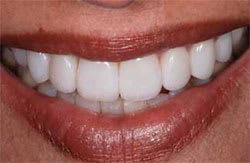John F. Weston, DDS
Conservative correction of anterior teeth exhibiting rotations, poor symmetry, discoloration, and wear is a common patient request (Figure 1, 2, 3). Creating natural contours and undetectable restorations requires precise planning, accurate preparations, and detailed laboratory communication. The goal should always be to conserve as much tooth structure as possible while allowing the ceramist the proper amount of space required for porcelain. This case shows a conservative restorative result achieved using the Lava™ Chairside Oral Scanner C.O.S. (3M™ ESPE™, https://www.3mespe.com).
Overview and Patient History
A 45-year-old female presented with a chief complaint about her smile esthetics and shade. The examination revealed moderate incisal wear and rotations, as well as a porcelain-fused-to-metal crown on tooth No. 12. After discussion, she agreed on placement of conservative porcelain indirect restorations on teeth Nos. 5 to 12.
Records and Smile Design
A complete AACD series of photographs was made, along with preoperative models, a face-bow record, and a passively obtained open-bite centric relation jaw record. With the intraoral mockup following basic smile design principles, the author was able to simulate the final result and gain patient approval. Incisal and facial reduction guides and provisional template impression were made prior to removing any of the mockup.
Clinical Session
Teeth were properly but not overly reduced. Typically, 1.5 mm is needed for proper incisal edge development and a minimum of 0.2 mm to 0.5 mm facial reduction. The margin must be carried interproximally and into the contact areas to avoid seeing the veneer margins at the proximal gingival areas. Provisionals were fabricated using Protemp™ Plus (3M ESPE) and the template impression of the mockup. The C.O.S. uses high-resolution video to create an extremely accurate 3D file (Figure 4) in order to fabricate an SLA model on which any restorative material can be used. In this case, a thin pressed material was employed (Figure 5 and Figure 6).
Delivery
Provisionals were atraumatically removed, then the teeth were scrubbed with chlorhexidine and pumice. Using rubber dam isolation, a complete dry try-in was accomplished to verify marginal integrity and proximal contacts. A total-etch light-cure technique was implemented using Adper™ Scotchbond™ Multi-Purpose Plus Adhesive (3M ESPE) and translucent RelyX™ Veneer Cement (3M ESPE). Gingival cement was removed using a #12 blade. No burs were used on the facial margins. The occlusion was verified and lingual surfaces polished with a fine football diamond and rubber points (Shofu, https://www.shofu.com).
Conclusion
The bonding of porcelain to enamel is one of the most predictable bonds in clinical dentistry. In the author's opinion, cases should always be designed to accomplish desired restorative corrections by altering the fewest teeth and removing the least amount of tooth structure. This case represents all that dentists strive to accomplish with modern materials and techniques while meeting the goal of conservative, reliable, and functional smile reconstruction (Figure 7, 8, 9).
The author would like to acknowledge the ceramist, Todd Cochran, Horizontal Dental Studio.
Figure 1 Pre-operative smile displaying wear and discoloration. | Figure 2 Lateral view shows degree of rotations. | ||||||
Figure 3 Close-up view showing improper length-to-width ratio. | Figure 4 High-resolution digital impression. | ||||||
Figure 5 SLA model showing excellent marginal fit. | Figure 6 Restorations on articulated SLA model. | ||||||
Figure 7 Postoperative smile showing improved shade and smile line. | Figure 8 Correction of rotations and facial profile. | ||||||
Figure 9 Improved proportions and detail of subtle imperfections. | |||||||
| |||||||









